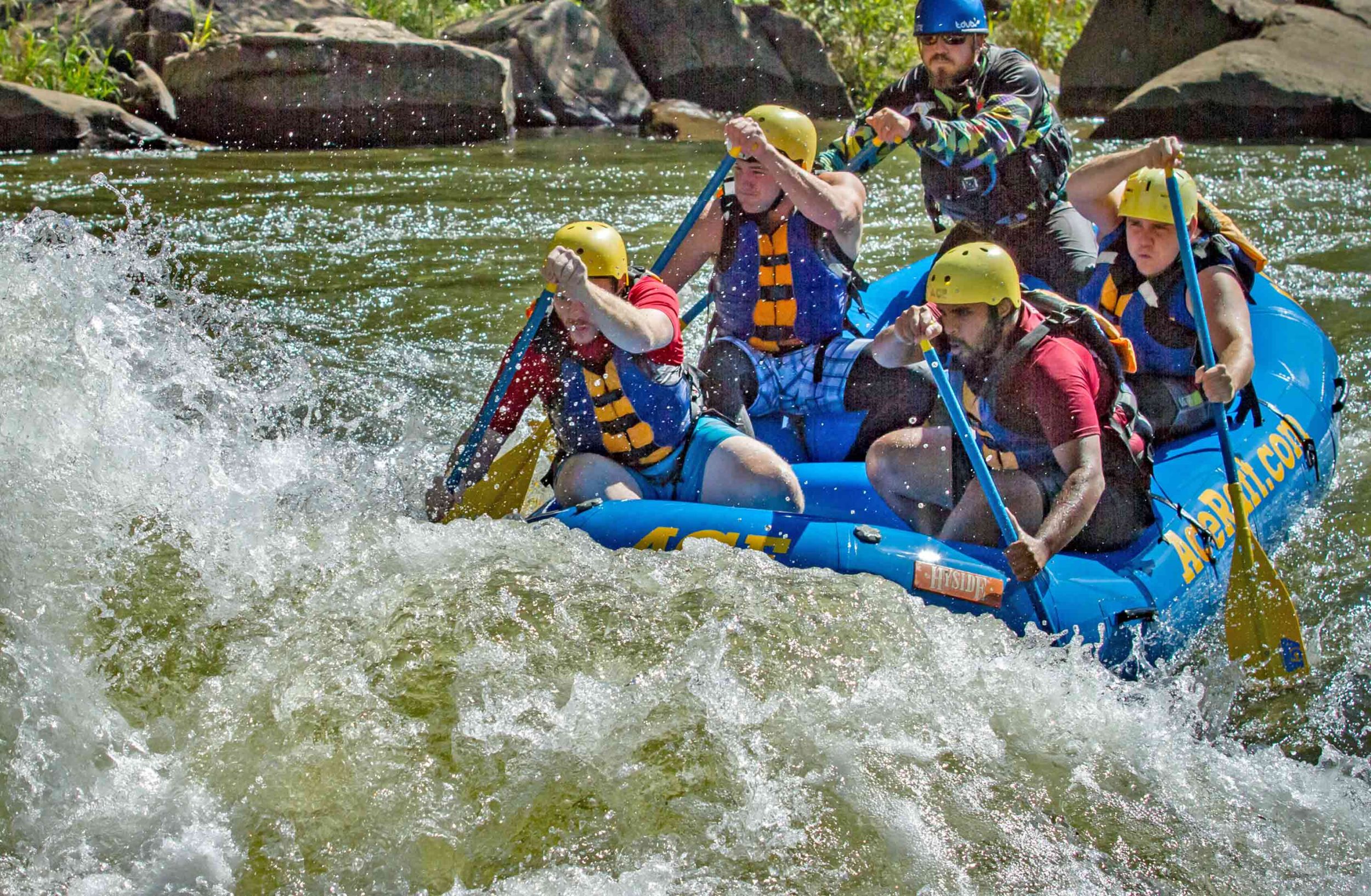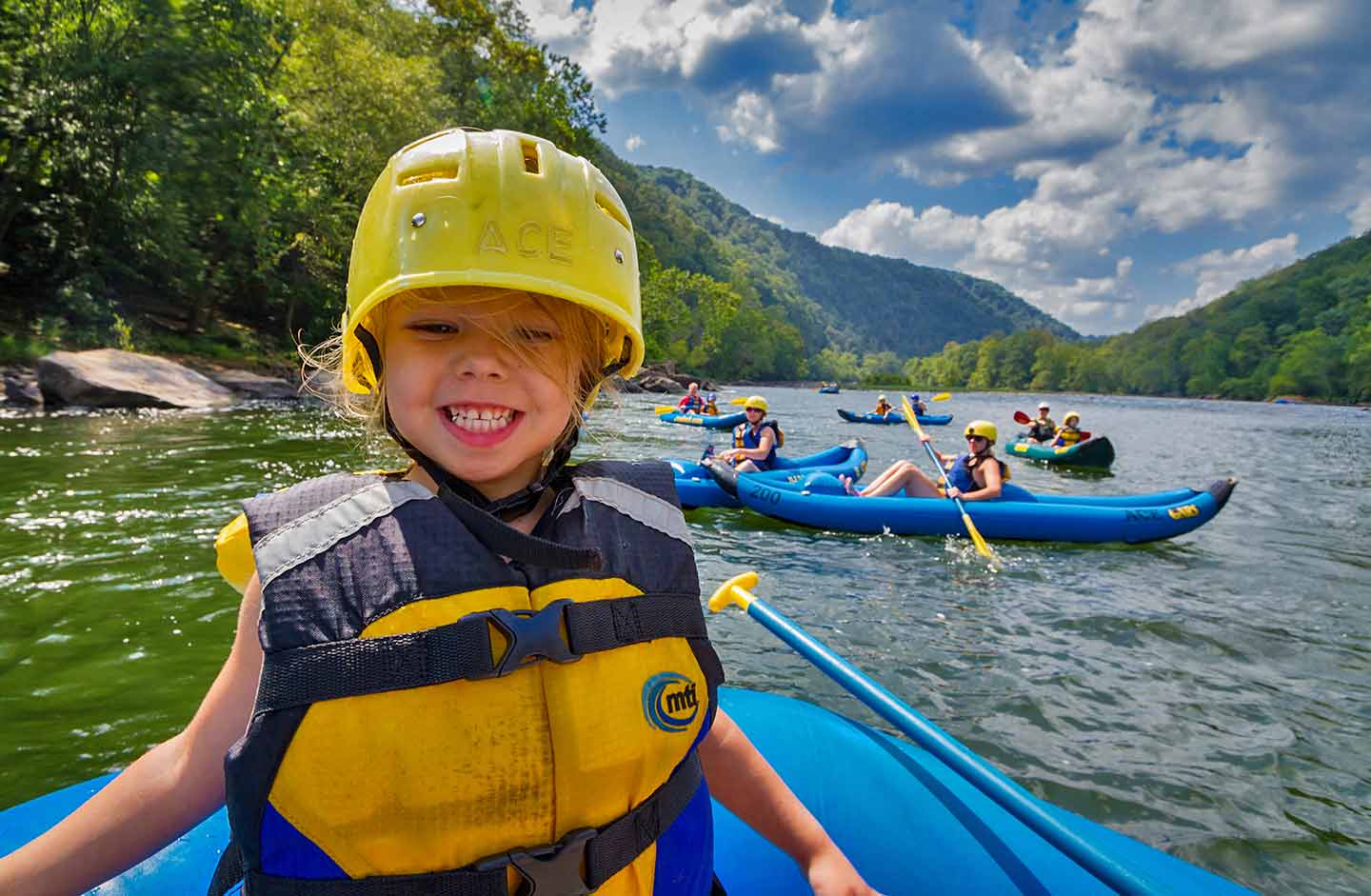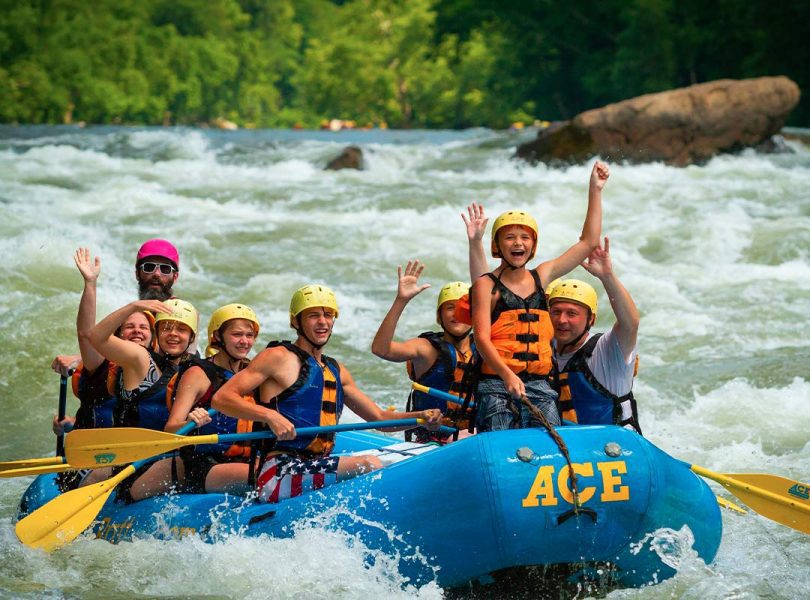
January 24, 2020
Whitewater Rafting Safety Tips
So you’re going whitewater rafting? Good decision! Are you scared? Maybe just a little? You probably have some questions to help you prepare for your upcoming epic vacation. You’ve come to the right place! Whitewater rafting is a fun outdoor recreational sport with over a million participants nationwide each year. You want to go rafting and you want to stay safe. We think that sounds like a great idea, so we came up with this list of whitewater rafting safety tips and best practices to help ensure you have a great experience and are prepared for situations you may encounter.
1. Dress to Impress
Before you check-in for your trip or meet your guide, you’re going to (we hope) get dressed. What you wear for your whitewater trip can greatly affect your comfort level and your overall enjoyment, that’s why it’s one of the most important whitewater rafting safety tips. When choosing what to wear it’s important to take into consideration the air temperature, the water temperature, and the weather for the day. If it’s cold outside you can bet the water will be cold as well. The New River is a naturally flowing river and as such the temperature varies by season. Think colder in the spring and the fall and warmer in the summer. The Gauley River is impounded by Summersville Dam and the water flows from the bottom of the lake and stays a fairly constant chilly temperature year-round. If the weather is sunny, make sure to pack sunscreen or a light long sleeve shirt to ward off the sun. Pro Tip: if the weather calls for rain leave your rain jacket in your car and rent a splash top from ACE (or just own the fact that you’re going rafting and are going to end up soaked) that way you have a dry jacket for when you return from your trip.
So what to wear? Let’s start with what not to wear. First, cotton. Cotton is warm and comfortable when dry, but when it gets wet it draws heat away from your body leaving you colder than if you were wearing nothing at all. Again, we wholeheartedly encourage you to go rafting clothed. Instead, wear layers made of polyester, fleece, wool, or polypropylene. All these materials hold heat in even when wet keeping you warm and comfortable. If temperatures are really cold, a neoprene wetsuit over top of a synthetic base layer will keep you even warmer. Don’t have a wetsuit? We’ll rent you one. We have a ton, seriously. If the weather is warmer, bathing suits, swim trunks, board shorts, and a t-shirt are the most common apparel. Remember, even in the summer you can remove a layer.
Let’s not forget your feet! Your feet will be near the water all day so go ahead and assume they are going to get totally wet. In the summer, water shoes, sandals with a secure heel strap, crocs, or even an old pair of sneakers are great footwear choices. In colder temperatures, wool socks with old tennis shoes or sandals (I know, I know, socks with sandals) help hold in heat. We also rent neoprene booties to keep keep your feet toasty warm.
Get the Gear: Whitewater Rafting Safety Tips
On the day of your rafting trip you will be given (or more accurately lent. We’re gonna need those PFDs back) three pieces of gear: A PFD, a helmet, and a paddle. These are the three most essential pieces of gear and it is important they are worn and handled correctly, making them another important whitewater rafting safety tip.
2. PFD
More commonly referred to as a life jacket, a PFD, personal floatation device, is designed to float the wearer as long as it is worn, buckled, and properly adjusted, (read: tight). A guide will adjust the PFD to fit you. Take a big breath in because it’s going to be tight. The PFD should sit low and tight around the torso. The lower the PFD is on your body the higher your head will float out of the water in the event you find yourself (voluntarily or otherwise) outside of the raft. Tight adjustment around the torso ensures the PFD stays in place on your body while swimming or being helped back into the raft. If the PFD is too loose, it will still float, it just won’t float with you properly. So, pay attention to how tight your guide makes your PFD. If your PFD becomes loose, tighten up the three pairs of straps on the side by grabbing and pulling them forward. Most importantly, don’t loosen up the straps.
3. Helmet
The next piece of gear is a helmet. Helmets protect your head from bumps and impact. Helmets adjust in two places. First, around the crown of your head. This adjustment is found in the back and works like the adjustment on a snapback ballcap. You’ll want this to be snug enough that it doesn’t slide back or down over your eyes. Also, it should not be so tight that it cuts into your head or sits up on the crown of your head. The second adjustment is the chin strap underneath. This can be adjusted by pulling the strap through the buckle until you can fit two fingers between your chin and the buckle. It doesn’t need to be so tight that you can’t talk or laugh. Depending on your trip, helmets may not have to be worn all day, so ask your guide when it is appropriate to take your helmet off.
4. Paddle
Whitewater rafting safety tip number 4! Paddles are the most important and most potentially dangerous piece of equipment you’ll be issued. Paddles are essential for rafting. They complete your brace in the raft and help you move the boat where it needs to go. So, listen to your guide, paddle when and how they tell you and hold the paddle properly. You’ll have one hand on the end shaped like the letter “T”, the T-grip, and one end of the shaft, in the middle, and the big flat part, the blade, goes either in or out of the water per your guide’s instructions. Always hold onto the T-grip and be mindful of where your blade is. Both of these can potentially cause injury to you or others in your raft.
5. Let’s go rafting!
Ready to go rafting? Not quite, but almost! Let’s talk about a few more whitewater rafting safety tips. We still need to cover parts of how to sit in the raft and how you can help yourself stay in the raft.
Parts
Rafts are composed of three parts: the outer tube, a large tube around the outside of the boat that gives it its shape and most of its buoyancy, cross tubes across the middle of the boat which gives it torsional stability (and give us places to strap coolers in because riverside lunch!), the floor, located under the outside tube, and cross tubes, the floor drains water out of the raft that may (hopefully) splash into your boat.
Sitting
When you sit in your raft (don’t worry your guide will demonstrate this to you before your trip), sit with your whole body on the outer tube with both legs inside the raft. Turn to sit facing forward. Tuck the toes of one foot forward underneath of the cross tube or foot cup in front of you and press up. Don’t wedge this foot in so hard that it cannot easily come out, doing so could result in possible injury to your knee or ankle. The heel of your other foot should be pushed firmly against the tube behind you. This will help keep you braced in the raft if waters (hopefully) become a little choppy.
Bracing
Your brace does a good bit to help keep you in the raft, but it’s not the only thing. Other things you can do are: paddle when your guide tells you. Participation in paddling helps put your raft where it needs to be on the river. Paddling also helps push you back into the boat because of the resistance of the blade in the water. Your guide may also give you commands like “high-side!” either left or right which is your cue to congregate everyone in the raft to either the left or right side of the boat. The “high-side” of the boat is the side of the boat which is higher in the air. Successful completion of this maneuver can help keep you in the boat or even prevent it from flipping over entirely. Your guide may tell you to “Get down!” This means you’ll unbrace your feet and slide down off the outside tube and sit on the floor of the raft, but be ready to “Get up!” because you’ve got more paddling to do!
6. Swimming like you mean it!
So far we’ve been talking about what happens when you stay in the raft. If you go rafting often enough you’re bound to find yourself swimming in the river at some point. It happens to everyone, even your guide.
Falling out of the boat isn’t the worst thing that can happen, especially if you’re prepared and know how to react. First, if you feel yourself falling out of the raft, your head’s underwater but your feet are still in the boat, snatch your feet out. Curl yourself into a ball while under the water. Assume the fetal position. Aside from giving you a contemplative moment to reflect on what just happened, balling up reduces the area of your body that the river’s current can grab onto. This means you spend less time getting spun around and instead you pop to the surface like a beach ball. Once you are at the surface, orient yourself, look for your raft, keeping in mind it may be behind you, and grab ahold or swim toward the raft or to the direction your guide told you to prior to the rapid. If you’re in the water and your guide or any other guide points in a direction, swim that way. All guides will point to safety, never towards a hazard.
When swimming, it is very important to never try to stand up in the river. If you try to stand up, even in very shallow water, your foot can become stuck between objects on the riverbed. The force of the river’s current can push your body underwater and hold you there.
If you are unable to swim or become disoriented in a rapid, you can alternatively assume the defensive swimming position. Rollover on your back with your feet sticking up at the surface of the river where you can see them. You can use your legs as a shock absorber to push off on any rocks you may encounter.
7. Assisting in a rescue
Maybe someone fell out of your raft, but you managed to stay in. You can help that person in the water return to the raft by handing them your t-grip (the only time it’s OK to let go of your t-grip) and pull them back towards the raft. Then, you can grab the shoulder straps of their PFD and pull them back into the raft-this is another reason that it’s important for your PFD to fit snugly. If you’re the one swimming and you still have a hold of your paddle, you can reach your t-grip out to the people in your boat and have them pull you to them.
8. Throw bag
In the event that you end up a little bit too far away from your raft, your guide may throw you a bag filled with a length of rope. This is called a throw bag. Make sure you grab the rope, not the bag. Grab onto the rope firmly with two hands, do not wrap the rope around your hand or any part of your body, as this could become a dangerous situation in the current. Hold onto the rope and let your guide pull you back into the raft. Roll over on your back and point your head towards the raft so you don’t get a face full of water.
9. Flips
Sometimes, the entire raft may flip over. If this happens, stay calm. Try to stay near the raft and grab onto it if you can. Listen to your guide for instructions. Your guide will climb back onto the raft and flip it over using a length of cord. You’ll have to let go of the raft while they are doing this. To keep the raft from flipping, your guide may call certain commands, like “highside”, which means that everybody will need to get to one side of the raft. This is usually the downstream side of the raft.
10. Listen to your guide. No, seriously.
Your most readily available safety resource is your guide. All the guides at ACE Adventure Resort want to ensure you have a safe enjoyable trip and come back for more! If you have a question, ask your guide. At ACE, we pride ourselves on having the best guides in the industry, and all of our guides have completed extensive safety training. We love to have fun but always keep safety at the forefront.

Bringing you all the latest whitewater rafting, adventure, and all things ACE from the New River Gorge of West Virginia for over 40 years.










